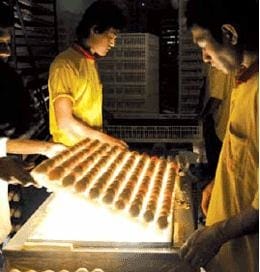THE C.H.I.C.K. PROGRAM – A GIANT STEP CLOSER TO THE CLIENT
The Ceva Hatchery Injection Control Keys Program or C.H.I.C.K.® Program clearly illustrates the new type of collaborative work Ceva strives for with its clients. By going directly into hatcheries to support breeders and provide a comprehensive range of services, Ceva has a unique opportunity to effectively build its experience. This partnership offers clients a service tailored to their specific needs, while giving Ceva an extensive field for a wide variety of full-scale experiments.
.
The C.H.I.C.K. Program, as Seen by CEVA's Clients
“We started vaccination in the hatchery at the end of 2009. In our experience, hatchery vaccination with Cevac® Transmune IBD is one of the key factors in improving Gumboro protection and therefore yields, and the overall performance of our broilers. Ceva helped us tremendously, and we are grateful to the company for providing us with end-to-end service from hatchery vaccination through to broiler performance monitoring,” said Achmad Dawami, Vice-President and Broiler Business Unit Director.
“Working in collaboration with Ceva is a great experience. Ceva has constantly made big efforts to enhance its vaccines and vaccination technologies. As a client of Ceva, I have seen that they always provide the best service possible and are always attentive to any remarks we might make,” commented Dr Ng Hon Yean, Director of the Breeding Operation Techniques Department at CP Malaysia.
.
What is the C.H.I.C.K. Program?
Industrial vaccination in the hatchery offers many advantages but requires two things:
- Vaccination expertise to administer the right dose at the right time, check its effect, and decide on any necessary corrective measures,
- Experience to offer the full benefits of sophisticated technologies, including assistance using the machines, control and regulation operations, needle cleaning operations, maintenance and troubleshooting.
Both these demands require a high level of expertise, staff training and end-to-end process monitoring. In response, Ceva created the C.H.I.C.K. Program to accompany hatchery professionals in five ways: products, vaccination equipment, vaccination techniques, vaccination monitoring in terms of injection quality, and staff training. This support is placed under the responsibility of dedicated managers in charge of rolling out the C.H.I.C.K. Program on client premises.
- The first phase consists of gaining thorough understanding of specific breeder issues, helping them define the best organization protocol: machine selection, vaccination organization, and staff training.
- In the second phase, Ceva guarantees its client a presence during vaccination to measure vaccine efficacy and check compliance with good practices.
- Finally, Ceva handles machine maintenance and repair, and various reporting activities.
.
The C.H.I.C.K. Program in Action: Wayne Farms
Wayne Farms is one of the largest broiler integrators in the United States, and Ceva has worked with great care to establish a sound working relationship with the company in addition to their commercial roles.
The aim is to set up a model for partnership that enables us to share our values and set Ceva apart from competitors. A series of commercial objectives defines the relationship between the two partners, but the biggest innovation is joint trials to develop new ideas.
Aristotle put forward the idea that the whole is greater than the sum of its parts. By working together, Ceva and Wayne Farms can develop, test and register new poultry vaccines more quickly. Shortening the time to market for highly efficacious vaccines provides an edge for both companies and for the industry as a whole. Sure, safe supplies of poultry mean having the possibility of feeding an ever-growing population.
(Source: www.thepoultrysite.com)
Related topics: c.h.i.c.k. program client ceva partnership

 Corporate Website
Corporate Website
 Africa
Africa
 Argentina
Argentina
 Asia
Asia
 Australia
Australia
 Belgium
Belgium
 Brazil
Brazil
 Bulgaria
Bulgaria
 Canada (EN)
Canada (EN)
 Chile
Chile
 China
China
 Colombia
Colombia
 Denmark
Denmark
 Egypt
Egypt
 France
France
 Germany
Germany
 Greece
Greece
 Hungary
Hungary
 Indonesia
Indonesia
 Italia
Italia
 India
India
 Japan
Japan
 Korea
Korea
 Malaysia
Malaysia
 Mexico
Mexico
 Middle East
Middle East
 Netherlands
Netherlands
 Peru
Peru
 Philippines
Philippines
 Poland
Poland
 Portugal
Portugal
 Romania
Romania
 Russia
Russia
 South Africa
South Africa
 Spain
Spain
 Sweden
Sweden
 Thailand
Thailand
 Tunisia
Tunisia
 Turkey
Turkey
 Ukraine
Ukraine
 United Kingdom
United Kingdom
 USA
USA
 Vietnam
Vietnam





